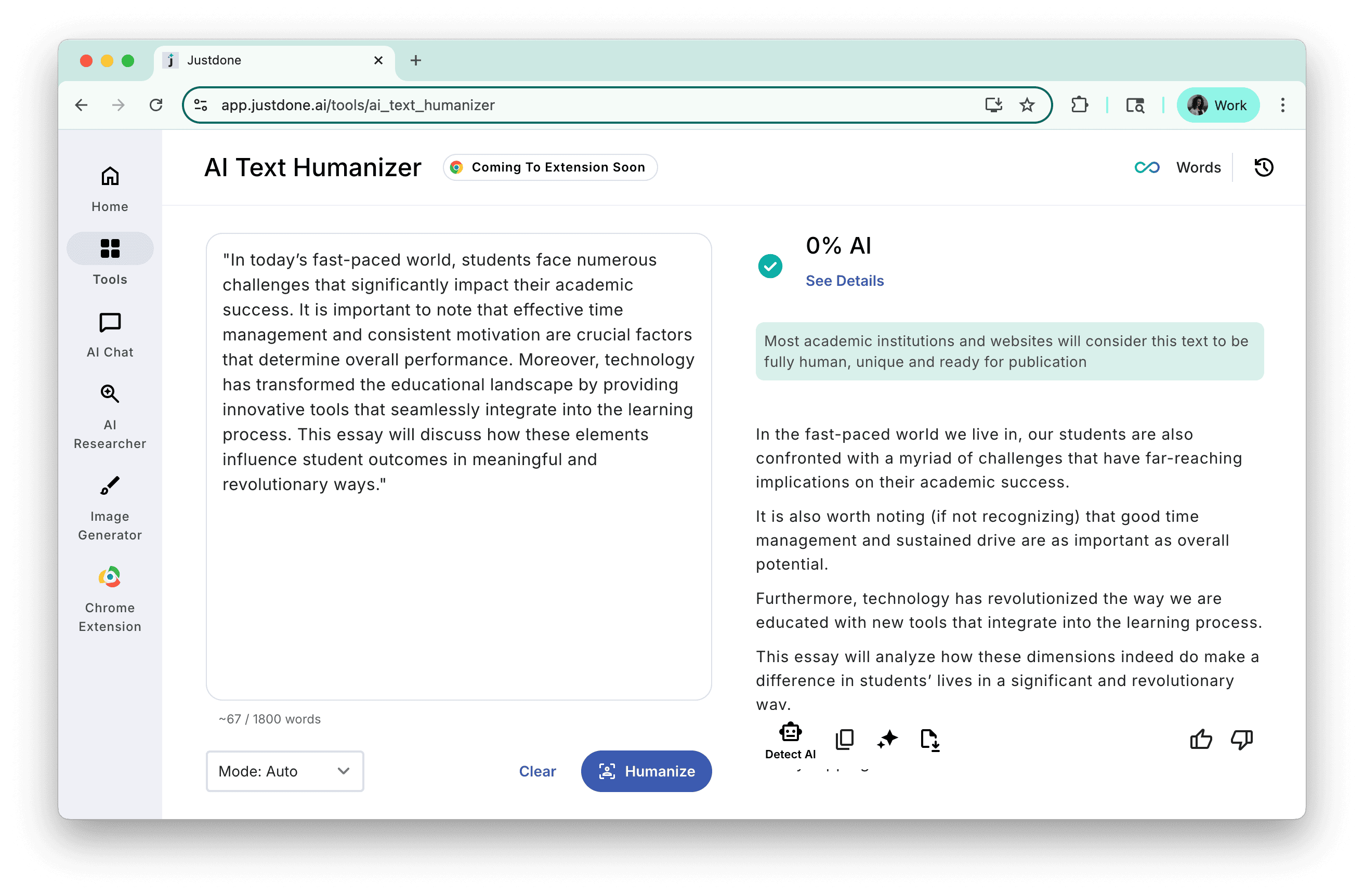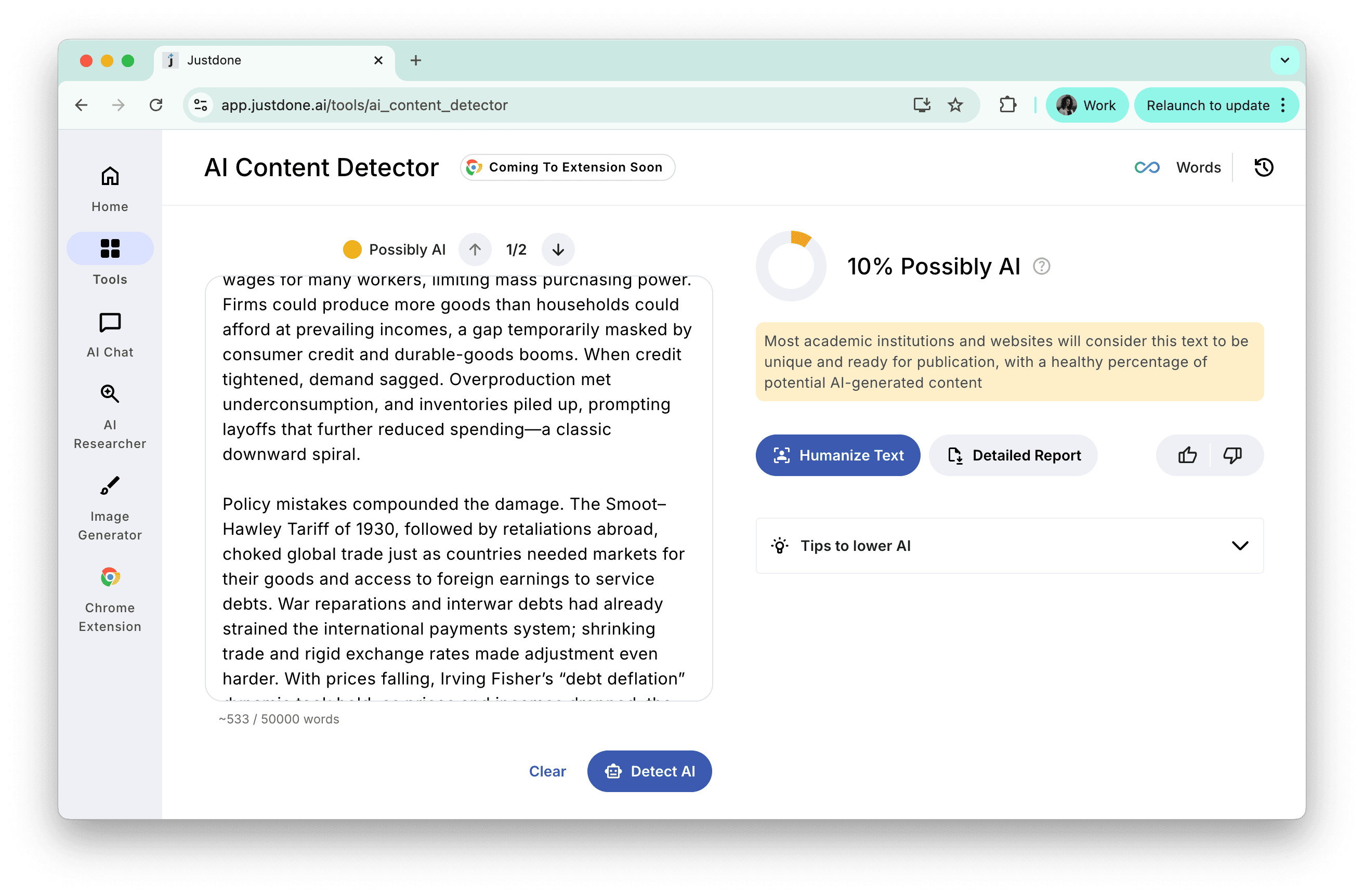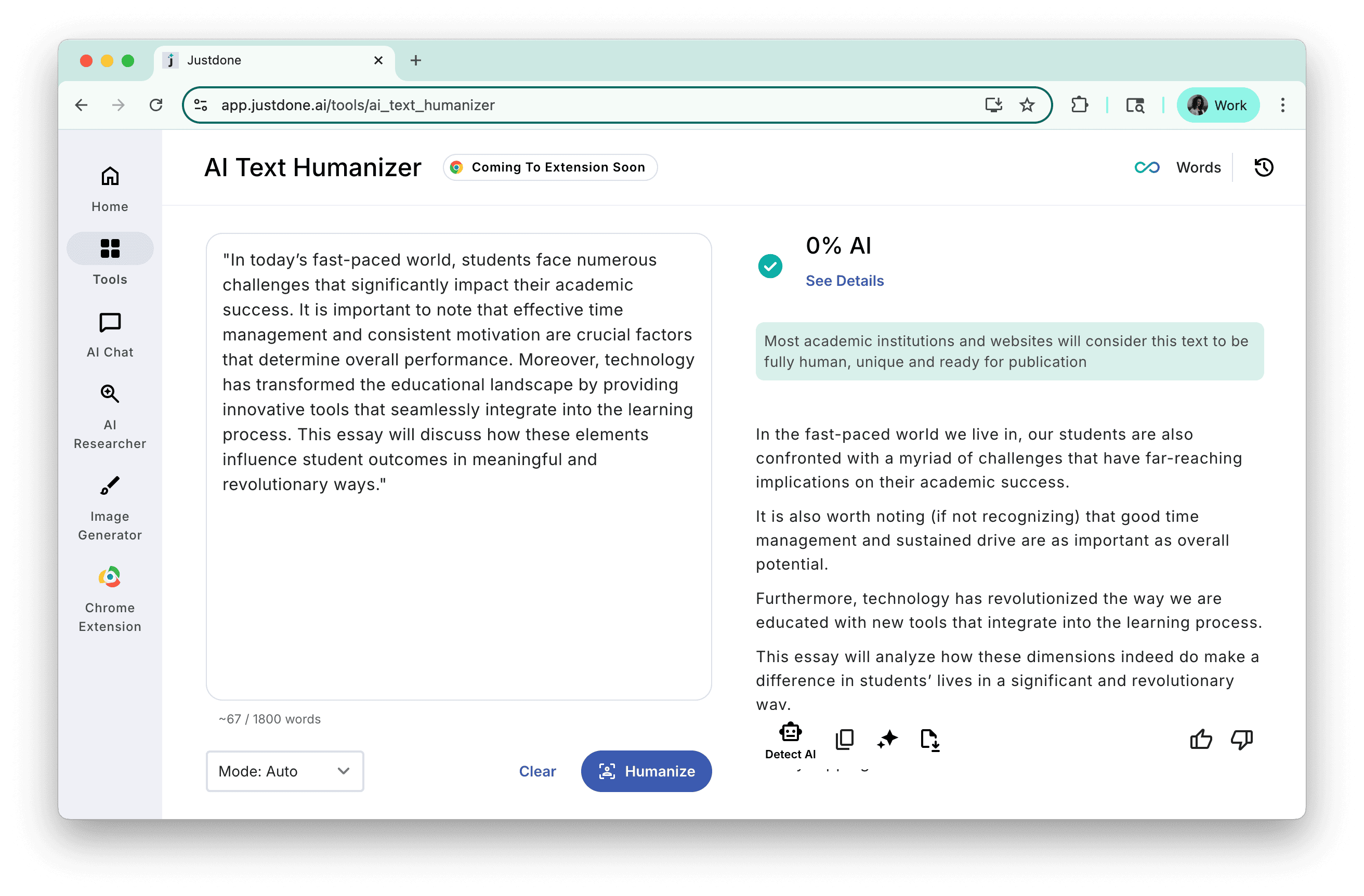AI writing tools like ChatGPT are great for learning because they give you speed and productivity. But with them comes a growing challenge: passing AI detection tools used by platforms like Turnitin. Students, content creators, and professionals often worry that their AI-assisted text will be flagged, even if it’s been carefully edited. The good news is that you can make AI-generated content sound like your natural voice without losing clarity or originality. This guide will walk you through how to pass AI detection, including how to pass Turnitin AI detection, how to make ChatGPT pass AI detection, and maintain a strong personal style simultaneously.
How AI Detection Works
Before you can bypass AI detection, you need to understand how AI content detectors work. In short, most detection tools analyze patterns such as overly predictable word choices, repetitive sentence structures, and uniform rhythm. They look for linguistic markers that AI tends to produce, like balanced sentence lengths or transitions that sound mechanical. Turnitin’s AI detection, for example, measures “burstiness” and “perplexity” — in other words, how varied and unpredictable the writing is.
A common mistake is assuming that simply paraphrasing AI-generated text will make it undetectable. In reality, poorly done paraphrasing can make the text sound even more artificial. Recent studies show that style changes, not just synonyms, are usually enough to push many detectors toward coin-flip performance. That’s why your approach must go beyond synonyms and rearranging sentences — you need to infuse genuine human qualities into your writing.
7 Ways to Make Your Writing Sound Human
If you use AI writing tools to help with your writing assignment, it is ok. Don't overuse them, and you will never get flagged. You can make AI-generated content sound like your natural voice without losing clarity or originality.
- Use an AI humanizer tool. Humanizers can help you shape AI drafts into more natural language patterns. The purpose isn’t to “hide AI,” but to learn what human rhythm looks like: varied sentences, natural tone shifts, and more expressive flow.
- Write simply. Keeping things simple is a great way to pass AI detectors. It also improves readability, and your audience will thank you.
- Use an active voice. AI writers tend to waffle and overuse passive voice, making the writing sound robotic.
- Apply copywriting techniques. AI-generated writing usually informs rather than persuades.
- Manually edit the AI-generated content. Add personal touches and unique insights that AI can't replicate.
- Use a unique writing style. Most AI writing software cannot replicate personal writing styles. Bullet points and broken lines add to the charm, too.
- Write the article yourself. Sometimes, the most authentic option is still to create the content by hand.
I propose that you look through the guide that will walk you through how to bypass AI detection, including how to pass Turnitin AI detection, how to make ChatGPT pass AI detection, and make AI text read like human writing.

As you can see, the style of this piece was changed significantly, and this allowed it to bypass AI detection with a 0% result.
How to Make ChatGPT Pass AI Detection
If you want ChatGPT to produce text that requires minimal editing to pass AI detection, you can guide it during the prompt stage. Ask it to:
- Write with varied sentence lengths, mixing short and long sentences.
- Use a conversational tone with occasional informal phrasing.
- Include rhetorical questions and personal examples.
- Avoid perfect balance in paragraph structures.
For instance, instead of saying, “Write me a 500-word essay on the causes of the Great Depression,” you could prompt:
“Write me a 500-word essay on the causes of the Great Depression as if you’re explaining it to a curious college friend over coffee, mixing casual observations with historical facts, and varying the sentence lengths.”
Sometimes, it can work pretty well. However, an accurate AI detector can still flag AI in the output. See it on the screen from JustDone AI checker:

How to Pass Turnitin AI Detection Without Compromising Quality
Turnitin’s AI detection is one of the most challenging to pass because it combines plagiarism scanning with machine-generated text analysis. If you ask can Turnitin detect ChatGPT content, I’d say like this: if you paste raw ChatGPT output into your essay, the detector will likely flag it. The key is to use AI as a starting point, not an end product.
Start by generating a draft with ChatGPT. Then, read it as if you’re explaining the concept to a friend. Rewrite passages in your own cadence, inserting phrases or expressions you’d naturally use in speech. For example, if ChatGPT says, “It is imperative to note that climate change poses a significant threat to biodiversity,” you might rewrite it as, “If we’re being honest, climate change is hitting biodiversity hard, and the effects are getting worse.” This shift introduces unpredictability and personal tone — two factors that help pass Turnitin’s AI detection.
Also, you can use an AI humanizer. Do AI humanizers work on Turnitin? Yes, and they are very effective because they don't just paraphrase, but change the sentence structure and style to make the content undetectable.
How to Make Text Pass AI Detection With Human Editing
Once you have your draft, human editing is where the magic happens. Read the piece aloud and listen for parts that sound too smooth or formulaic. AI often avoids ambiguity, but human writing is full of it. Add moments of uncertainty, opinion, or digression - in other words, use small details that show a real person is behind the words.
You can also insert micro-stories or personal observations. If the original sentence says, “The city implemented new recycling policies in 2020,” you might change it to, “When the city rolled out its recycling rules in 2020, I remember standing in my kitchen reading the flyer and wondering how many neighbors would actually follow them.” These human touches break the AI pattern instantly.
Bypass AI Content Detection: The Role of an AI Humanizer
One of the most effective tools for making AI-generated text pass detection is an AI humanizer, like the one offered by JustDone. Unlike a basic paraphraser, an AI humanizer doesn’t just swap words; most importantly, it reshapes the rhythm, introduces natural irregularities, and keeps your voice intact.

If a passage from ChatGPT feels robotic, the humanizer can rework it so that it matches your style, complete with imperfections that make it sound authentic.
For example, “Renewable energy sources are becoming increasingly important in the fight against climate change” might come out of ChatGPT sounding perfect but predictable. After running it through the AI humanizer, it could become,
“These days, renewable energy isn’t just a nice idea — it’s one of the few real tools we’ve got to slow climate change.”
The shift in tone, pacing, and perspective makes it far less detectable. As a result, you’ll get almost clean result with no AI content detected.
Real-World Example: Turning AI Drafts Into Authentic Essays
A student once showed me a ChatGPT-generated paper on social media’s impact on teenagers. The draft was grammatically correct, but Turnitin’s AI detector flagged over 80% of it. We took the same paper and applied a three-step process: breaking up patterns, adding personal commentary, and running sections through JustDone’s AI humanizer. We also varied the flow — sometimes starting with a fact, other times with a story. The result was successful: the paper passed Turnitin AI detection, scored well academically, and still felt like the student’s voice.
Why Passing AI Detection Doesn’t Mean Losing Your Voice
Some students worry that changing AI-generated text to pass detection will strip away their style. The opposite is true. The process of making text pass AI detection can actually bring you closer to your authentic voice. That’s because when you rewrite with personal anecdotes, varied pacing, and natural imperfections, your writing becomes more alive. The aim isn’t to “beat the system” with random changes. You need to make your text reflect how you truly think and communicate instead.
Think of ChatGPT as your brainstorming partner. You wouldn’t submit your partner’s notes word-for-word, but you’d rather shape them into something that sounds like you. The same principle applies here.
You can use AI humanizer to bypass AI detection. Let's see how to humanize AI text in practice. Basically, you put in a piece you need to humanize, click humanize, and get the result that changes robotic patterns, transforms style and tone.

Avoid Common Mistakes When Trying to Pass AI Detection
The biggest mistake is over-relying on word substitution tools that produce awkward phrasing. Detectors can spot this easily, and readers can too. Another error is swinging too far in the opposite direction by over-complicating sentences in an attempt to “trick” the system. Overly convoluted writing doesn’t just raise suspicion — it hurts readability and makes your ideas harder to follow.
The goal isn’t to hide the AI origin completely; it’s to produce something that reads as naturally as if you had written it from scratch. When in doubt, focus on clarity, personality, and variety.
Besides, I recommend always balancing speed and authenticity. Passing AI detection takes time, especially at first. But with practice, you can build a workflow that’s both fast and effective. Many students now start with a ChatGPT outline, draft a rough version, then do a pass with their own edits, followed by a final polish using an AI humanizer. This approach saves hours while still producing work that reflects their unique style.
Final Thoughts: Your Voice Is the Best AI Bypass
Learning how to pass AI detection doesn’t mean gaming the system; it’s about taking ownership of your work. When you adapt AI output into something that truly sounds like you (with your rhythm, your quirks, and your point of view), you naturally make the text pass AI detection tools, including Turnitin. Whether you’re figuring out how to make ChatGPT pass AI detection or how to make text pass AI detection, the principle is the same: AI should assist, not replace, your thinking and expression.
F.A.Q.
Which tool can fix AI detector flags?
There’s no perfect “undetectable AI” tool, but you can reduce flags by combining solid rewriting techniques with a reliable humanizer. Good tools help, but your own edits and natural voice make the biggest difference.
How do I reduce the robotic tone in AI drafts?
Vary your sentence lengths, add personal details, use everyday phrasing, and keep a few natural imperfections. You can also use tone-adjusting prompts to break AI patterns and make the writing feel more human.
What budget-friendly humanizer options exist?
Free tools can help a little, but they’re not very reliable alone. The best low-cost approach is using a simple tool for a first pass, then fixing tone, rhythm, and phrasing yourself to avoid that over-polished AI sound.